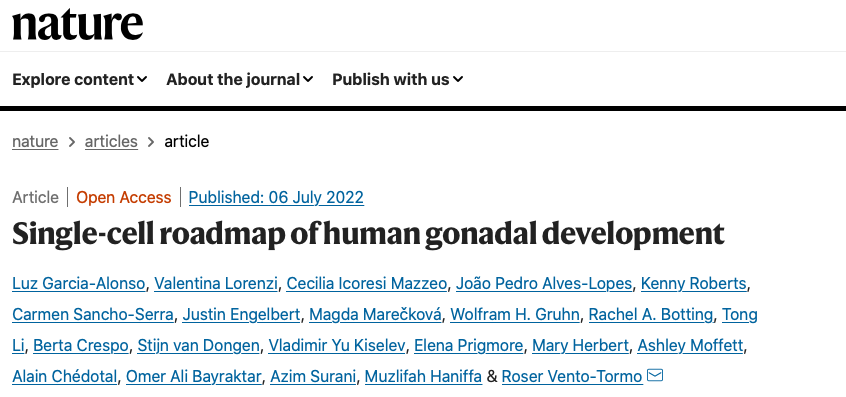After primordial germ cells (PGCs) have colonized the gonadal ridge at roughly 3–5 weeks post conception (WPC), two successive development stages are observed during male gonadogenesis: sex determination of the bipotential gonads and testis differentiation. At 6 WPC, the SRY gene becomes expressed in the bipotent supporting cells in the gonadal coelomic epithelium, ventral to the mesonephros in the XY gonadal ridge. SRY is required for Sertoli cell commitment and tilts the balance in favor of male gonadogenesis by creating a cascade of testis-promoting genes, which downregulate RSPO1/WNT4–β-catenin pathways that mediate ovarian development. The remainder of testis development is driven by sex hormones produced after the gonads have differentiated into testes.
Despite the social and biological relevance of testis development disorders and their association with the increasing incidence of male infertility, knowledge on human gonadogenesis is not complete. Current advances are hampered by scarcity of human tissue, lack of reliable in vitro models, and differences in reproductive physiology between rodents and higher mammals. Here, Garcia-Alonso and colleagues profiled cells of the human gestational gonads (n=22) from 6–21 WPC using (1) single-cell RNA sequencing, (2) single-cell accessible chromatin sequencing and (3) combined single-nucleus RNA and ATAC sequencing. Hereafter, gene activity was mapped in the tissues using Visium spatial gene expression and multiplexed single-molecule fluorescent in situ hybridization to provide spatiotemporal dynamics of male gonadogenesis.
Subpopulations of early supporting gonadal cells
The authors identified early GATA4+ supporting gonadal cells (ESGCs) in the coelomic epithelium of the bipotential gonad that express the stem-cell markers TSPAN8 and LGR5 (which would correspond to an equivalent population in mice expressing WT1 and NR5A1). These ESGCs are the cells that transiently express SRY (6–8 WPC) to differentiate into supporting Sertoli cells in the early gonad, which are required to complete testis development. Moreover, ESGCs at the gonadal–mesonephric border of the gonads will upregulate PAX8 at 9 WPC and are believed to influence rete testis formation.
Testis-specific resident macrophages
Of relevance to the immune regulation in developing testes, the authors also provide insights into macrophage function. In addition to tissue-repair macrophages (92.2% of the macrophages in the testis), two rare fetal testis-specific macrophages (ftMs) were identified with an osteoclast-like (SIGLEC15+, 2.8%) or a microglia-like (TREM2+, 5%) signature. SIGLEC15+ ftMs are believed to promote the migration of endothelial cells from the mesonephros to the developing testis, suggesting they are critical for testis cord formation between 8–14 WPC. Meanwhile, TREM2+ ftMs signal to Sertoli and germ cells inside the cords, where they likely remove damaged cells by phagocytosis and modulate the inflammatory milieu of the testis through immunomodulatory molecules.
In summary, Garcia-Alonzo and colleagues provide a comprehensive spatiotemporal map of early gonadogenesis at single cell level, identifying two new supporting cell populations: (1) ESGCs (TSPAN8+/LGR5+) that will give rise to Sertoli cells, and (2) PAX8+ ESGCs at the gonadal-mesonephric interface that will give rise to the rete testis. Additionally, they identified two rare SIGLEC15+ or TREM2+ ftMs populations around and inside the developing tubular cords, respectively, with distinct functions. Their work means a big step in the study of human testis development, contributing to understand male (in)fertility.
Human female and murine male single cell profiles during gonadogenesis were also characterized; read the full text if interested: https://doi.org/10.1038/s41586-022-04918-4

